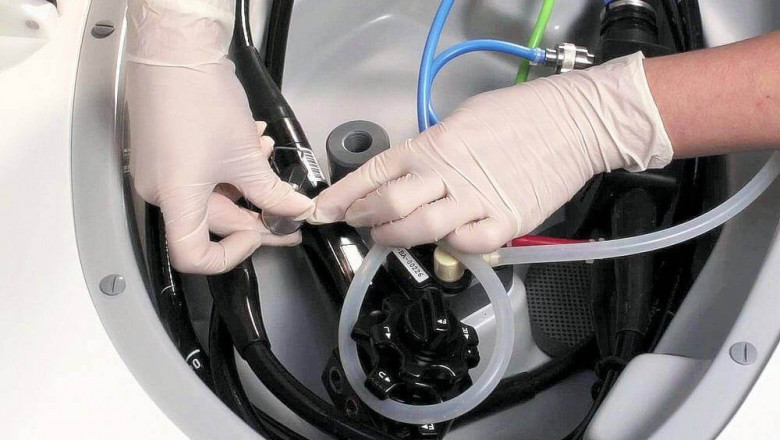views
Endoscopy is a valuable medical procedure that allows doctors to examine the inside of a patient's body without needing to perform invasive surgery. During endoscopy, a flexible tube called an endoscope is inserted into the body through the mouth, anus, urethra, or other openings. The endoscope has a tiny camera and light at the tip that allows the doctor to visualize internal organs. Common endoscopic procedures include colonoscopies, bronchoscopies, and upper and lower gastrointestinal (GI) exams.
After each procedure, the used Endoscope Drying Cabinets must be thoroughly cleaned and disinfected prior to the next patient use. This reprocessing is essential to prevent the spread of infections between patients. The multi-step manual cleaning process involves flushing channels, brushing surfaces, and soaking in disinfectants. Residual moisture left behind can harbor bacteria and other pathogens if not fully dried.
The Role of Endoscope Drying Cabinets
Following manual cleaning, endoscopes must be dried completely before storage to prevent the growth of microorganisms. This is where endoscope drying cabinets play a vital role in the reprocessing workflow. Drying cabinets provide a controlled, heated environment to gently evaporate any residual moisture from the intricate channels and crevices of endoscopes.
Modern cabinet designs incorporate circulation fans to distribute warm, high-efficiency particulate air (HEPA) filtered air throughout the drying chamber. Programmable timers and alarms ensure endoscopes receive the appropriate length of drying cycle. Sensors may also monitor temperature and humidity levels to confirm the cabinet is operating effectively. Stainless steel or other antimicrobial-coated interiors help to maintain a hygienic environment during the drying process.
Common features of endoscope drying cabinets include adjustable racks and shelving for flexible or rigid scope types. Larger cabinets provide adequate space for simultaneous processing of multiple instruments. Automated data logging tracks key parameters for each cycle to facilitate quality control checks. Alarm indicators promptly notify staff of any drying issues that require attention.
Importance of Proper Drying Protocol
Inadequate drying leaves scopes vulnerable to microbial proliferations that can potentially transmit infections. Without regulated cabinet conditions, air pockets and crevices are likely to remain damp even after manual cleaning. Studies have shown that simply air drying endoscopes on a rack is insufficient and risks contamination of subsequent patients.
Instead, current professional guidelines establish minimum endoscope drying times based on cabinet temperature settings. The standard protocol is to dry at between 80-90°C for at least 20 minutes. Higher heat helps to penetrate small openings and evaporate any trapped moisture that could potentially harbor bacteria or viruses. Strict adherence to regulated drying is critical to support public health objectives of preserving patient safety.
Meeting Regulations and Infection Control Standards
Endoscope drying cabinets are classified as medical devices and must meet applicable quality and safety regulations. Manufacturers undergo rigorous product testing and certification under international standards organizations like the FDA and CE Mark. Well-designed cabinets provide documented evidence of design control, risk management protocols, materials evaluations and other compliance requirements.
Infection prevention teams also depend on drying cabinets to satisfy facility accreditation metrics, such as those instituted by The Joint Commission and Healthcare Facilities Accreditation Program. Regular maintenance, calibration checks and record-keeping support standards adherence. If cabinets malfunction or log incomplete cycles, it could jeopardize hospital accreditation or reimbursement statuses. Choosing a reputable equipment partner helps ensure long-term compliance.
Evaluating Long-Term Economics and Sustainability
While initial capital costs are higher than simpler drying methods, regulated drying cabinets offer far-reaching benefits over the life of the investment. Proper drying eliminates costly impacts of infection transmission events, regulatory non-compliance penalties or loss of accreditation standing. Efficient energy usage and automatic controls minimize operating expenses compared to manual alternatives as well.
Quality brands maintain value through long-lasting components and continuous software updates. Service agreements optimize performance and support technology refreshes. As regulations evolve, forward-thinking facilities select cabinets designed for easy retrofitting or future automation. The total cost of ownership underscores how regulated drying secures budgets, preserves reimbursements and safeguards patients - making cabinets an indispensable tool for quality endoscopy reprocessing.
As endoscopic procedures continue to increase in volume and complexity, maintaining the highest standards of instrument reprocessing becomes ever more crucial. Endoscope drying cabinets provide a controlled, regulated solution for ensuring all moisture is removed prior to storage or future use. Adhering to validated drying protocols helps prevent healthcare-associated infections and protects both patients and practitioners. Choosing medically-graded equipment from experienced manufacturers allows facilities to meet regulations, lower risks and demonstrate their commitment to infection control. Overall, drying cabinets represent a vital component of the full endoscope reprocessing workflow.
Get this Report in Japanese Language:
Get this Report in Korean Language:
About Author:
Money Singh is a seasoned content writer with over four years of experience in the market research sector. Her expertise spans various industries, including food and beverages, biotechnology, chemical and materials, defense and aerospace, consumer goods, etc. (https://www.linkedin.com/in/money-singh-590844163)






















Comments
0 comment